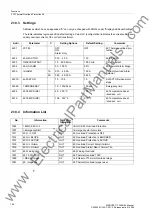
Functions
2.9 Frequency Protection 81 O/U
SIPROTEC, 7SJ62/64, Manual
C53000-G1140-C207-2, Release date 01.2008
184
2.9.2
Setting Notes
General
Frequency protection is only in effect and accessible if address
154
81 O/U
is set to
Enabled
during config-
uration of protective functions. If the fuction is not required
Disabled
is set. The function can be turned
ON
or
OFF
under address
5401
FCT 81 O/U
.
By setting the parameters
5421
bis
5424
, the function of each of the elements
81-1 PICKUP
to
81-4 PICKUP
is set individually as overfrequency or underfrequency protection or set to
OFF
, if the element is not required.
Minimum Voltage
Address
5402
Vmin
is used to set the minimum voltage. Frequency protection is blocked as soon as the
minimum voltage is undershot.
On all three-phase connections and single-phase connections of a phase-to-phase voltage, the threshold must
be set as a phase-to-phase value. With a single-phase phase-to-ground connection the threshold is set as a
phase-to-ground voltage.
Pickup Values
The setting as overfrequency or underfrequency element does not depend on the parameterization of the
threshold values of the respective element. An element can also function, for example, as an overfrequency
element if its threshold value is set below the nominal frequency and vice versa.
If frequency protection is used for load shedding purposes, the setting values depend on the actual power
system conditions. Normally, a graded load shedding is required that takes into account the importance of the
consumers or consumer groups.
Further application examples exist in the field of power stations. Here too, the frequency values to be set mainly
depend on the specifications of the power system / power station operator. The underfrequency protection safe-
guards the power station's own demand by disconnecting it from the power system on time. The turbo governor
regulates the machine set to the nominal speed. Consequently, the station's own demands can be continuously
supplied at nominal frequency.
Under the assumption that the apparent power is reduced by the same degree, turbine-driven generators can,
as a rule, be continuously operated down to 95% of the nominal frequency. However, for inductive consumers,
the frequency reduction not only means an increased current input, but also endangers stable operation. For
this reason, only a short-term frequency reduction down to about 48 Hz (for f
N
= 50 Hz) or 58 Hz (for f
N
= 60 Hz)
is permissible.
A frequency increase can, for example, occur due to a load shedding or malfunction of the speed regulation
(e.g. in an island network). In this way, the frequency increase protection can, for example, be used as over-
speed protection.
Dropout Thresholds
The dropout threshold is defined via the adjustable dropout-difference address
5415
DO differential
. It
can thus be adjusted to the network conditions. The dropout difference is the absolute-value difference
between pickup threshold and dropout threshold. The default value of 0.02 Hz can usually remain. Should,
however, frequent minor frequency fluctuations be expected, this value should be increased.
Time Delays
The delay times
81-1 DELAY
to
81-4 DELAY
(addresses
5405
,
5408
,
5411
and
5414
) allow the frequency
elements to be graded, e.g. for load shedding equipment. The set times are additional delay times not including
the operating times (measuring time, dropout time) of the protection function.
www
. ElectricalPartManuals
. com






























